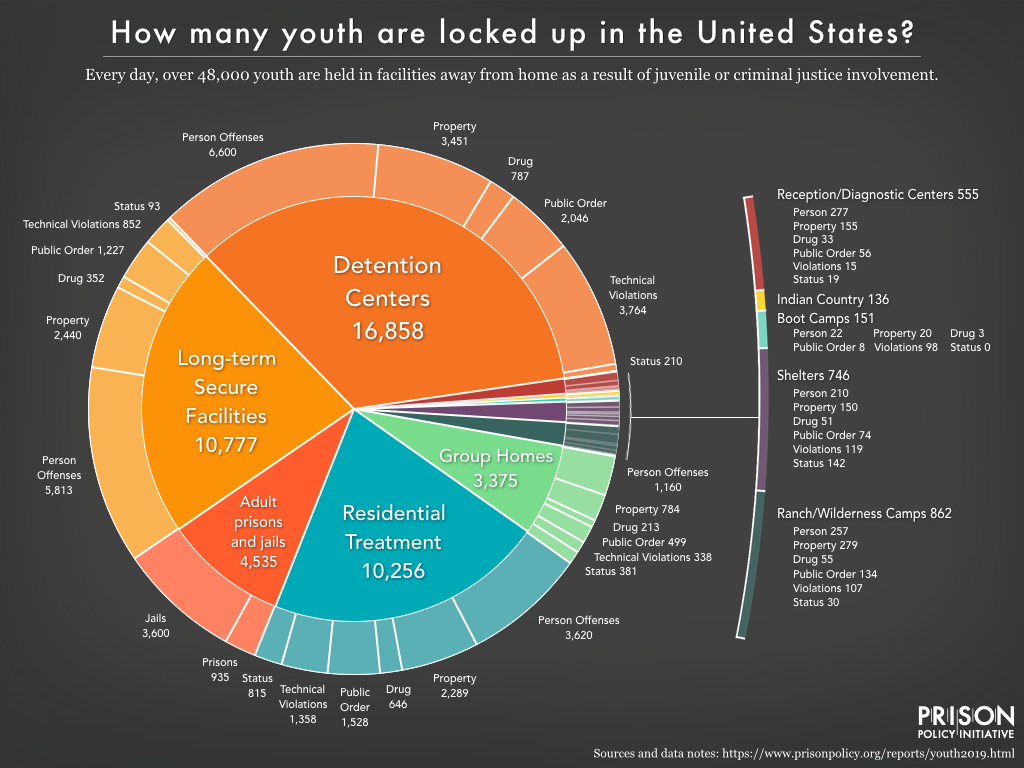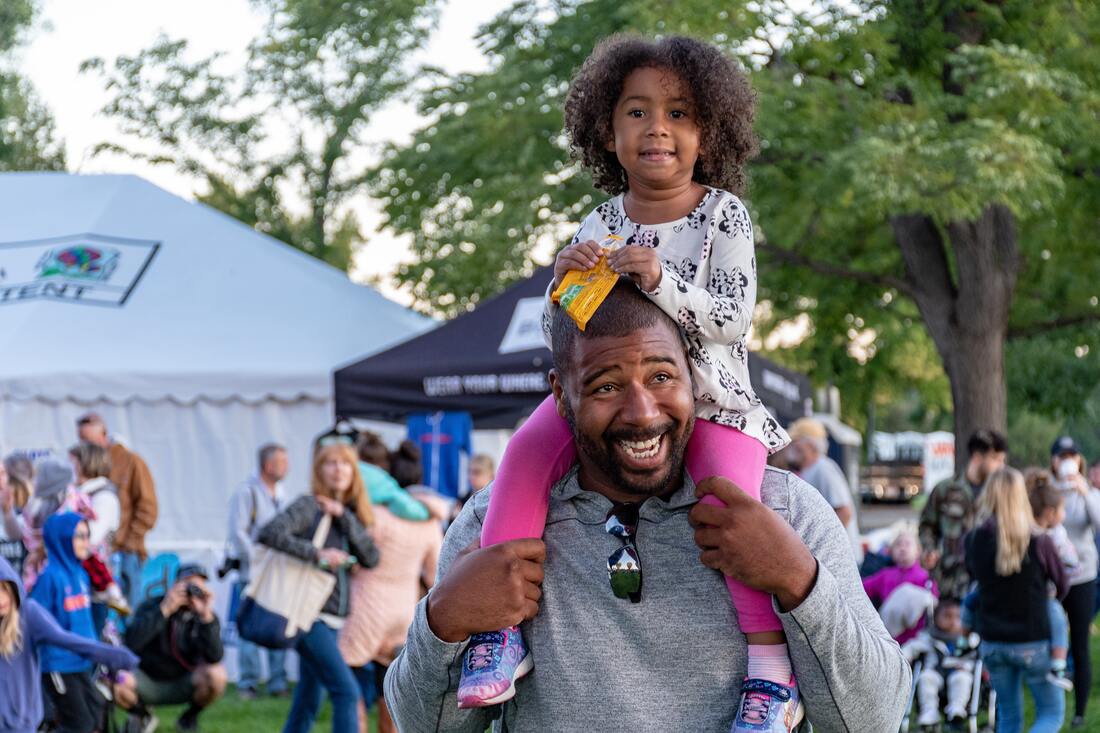|
States could release nearly 30 percent of the young people currently held in juvenile facilities across the U.S. without endangering public safety, says the Prison Policy Initiative (PPI).
The recommendation was one of several drawn from a report illustrating the “failures” in the juvenile justice system that “mirror failures in the adult system.” According to the report, 48,000 youths under the age of 18 were held in some version of confinement in 2019—a 60 percent drop since 2000. But while the declining population of incarcerated youth was a welcome trend, it left unaddressed the serious racial disparities, draconian discipline and unhealthy conditions that characterize the experience of those who still remain behind bars, according to Wendy Sawyer, Research Director of the PPI and the report’s author. “Two out of every three confined youth are held in the most restrictive facilities — in the juvenile justice system’s versions of jails and prisons, or in actual adult jails and prisons,” wrote Sawyer. And some 92 percent of confined youths are in locked facilities where they are subject to restraints like strait jackets or prolonged periods of solitary confinement—even though the nature of their offenses suggests they shouldn’t be confined at all, said the PPI. “By our most conservative estimates, states could release at least 13,500 more youth today without great risk to public safety,” according to the study, entitled “Youth Confinement: The Whole Pie 2019.” That number would include nearly 1,700 youth held for status offenses; 1,800 held for drug offenses other than trafficking; over 3,300 held for public order offenses not involving weapons; and 6,700 held for technical violations. “States should also look more closely at youth detained pretrial,” Sawyer recommended. “Beyond youth detained for those low-level offense categories, over 7,000 others are held before they’ve been found guilty or delinquent. “Many, if not all, of these youth would be better served in the community.” The falling population of confined youth has also exposed stark racial disparities, in which African-American and Native-American youth are over-represented. Some 42 percent of boys and 35 percent of girls in juvenile facilities are African-American, though only 14 percent of all U.S. youth under 18 are black. One of the most glaring contrasts found by the researchers was in the number of Native- American girls confined. Although Native Americans represent less than 1 percent of all U.S. youth, 3 percent of the girls detained—not including those held in tribal facilities—are Native American. The report also examined the types of facilities where young people are held around the country, noting that these can “affect their health, safety, access to services, and outcomes upon reentry.” Adult prisons and jails are regarded as the worst places, but even for those in juvenile detention facilities the conditions offer little hope for rehabilitation or treatment of problems relating to mental health or substance abuse. The report also noted that pretrial detention is “surprisingly common.” Over a quarter of delinquency cases commit young people behind bars who have not been sentenced, the PPI said. According to the PPI, the movements to reverse adult mass incarceration and to “de-institutionalize” justice-involved youth have remained “curiously distinct.” “But the two systems have more problems—and potentially, more solutions—in common than one might think,” Sawyer wrote. “The momentum of decarceration in the juvenile justice system must continue, and it should inspire bolder reforms in the criminal justice system as well.” To see the full report, please click here.
0 Comments
November 25, 2019 by Robert Franklin, JD, Member, National Board of Directors
It's a victory for Johnson who can now breathe a sigh of relief knowing she fought the system and finally, won. But is it a victory? Did Jean Johnson “win?” If so, it’s a Pyrrhic one. Jean Johnson’ son Lance was married to a woman who goes unnamed by this article (News4, 11/13/19). They had two children, but Lance’s wife had an affair with another man and gave birth to his child. She and Lance divorced and he was ordered to pay child support for his two children. DNA evidence cited by the court proved Lance to be the father of only those two. Documents obtained by News 4 show the courts have confirmed the child in question was fathered through a relationship the child's mother had with another man years ago, while she was married to Johnson's son. Lance seems to have paid the support he owed for his two kids, but the state child support enforcement agency, the Child Support Enforcement Division, decided he owed for all three children. It therefore began calculating arrears based on his non-payment for the child who’s not his. Lance moved out of state, but his mother, Jean, began a fight with the CSED to rectify its mistake and stop dunning Lance for money he didn’t owe. That fight took 12 years. Yes, 12 years. Now, exactly where the agency got the idea that Lance had been ordered to pay for three children is a mystery. [T]hat decree, the Order for Child Support dated 2004, clearly states that Jean's son Lance was to pay child support for two children, not three. Jean brought all that to the attention of CSED officials, but they ignored her. She persisted, but got nowhere. Eventually, the television station whose article is linked to got involved and received the same treatment. First we were told, the agency "can't disclose personal information." Then we received an explanation that "the Division operates from the documents provided." Finally, the state told us they "do not have the authority to change an order." Of course the agency can’t unilaterally change an order, but in this case, it didn’t need to. It just needed to “operate from the documents provided,” i.e. the court’s order. But it didn’t. Over many years, it continued trying to collect money from Lance that he didn’t owe and that court documents showed he didn’t owe. Eventually that all added up to a hefty $60,000. Finally, fed up, Jean Johnson went to court. The hearing took “only minutes” before Family Court Master Greg Shannon who ruled that the original order says what it says and ordered the state to recalculate Lance’s continuing child support obligation, if any. Is that a “victory?” In the sense that the judge did the right thing and the state was found to have wrongly charged Lance child support, interest and fees, yes it’s win. But in the sense that Jean Johnson spent 12 years of her life fighting a completely unnecessary fight, it’s not. How much time did she spend? How much money? And why did she have to do any of it? It’s tempting to chalk this one up to standard, off-the-shelf bureaucratic inertia and that probably played a role. But more likely, it’s a child support system that pays states for all the “support” they collect. The more they collect, the more they get paid. Lance Johnson was in their crosshairs, so, despite the fact that he didn’t owe for the third child, they didn’t go to the trouble of locating the actual dad, going to court, getting an order against him and adding another case to their stack of files. Instead of simply admitting their error, they just kept on doing what they did, i.e. that which was legally and morally wrong. And what was the child’s mother doing all this time? Did she explain matters to the state? Did she assist in righting an obvious wrong? And what about the third child’s actual father? He seems to have gone all this time without paying a penny to support it. Does he even know about his child? Who does the child (now an adult) believe to be its father? The state’s recalcitrance is bad enough by itself, but if it had done the right thing, the right man would have paid, Lance would have been let off the hook and Jean would have spent her time in better ways. But more importantly, responsibility for supporting the child would have fallen where it belonged and a child would have known its true father. Who knows, maybe he’d have gone to court to secure his parental rights and the two would have formed a real and meaningful relationship. More cities are punishing homeless people for sleeping in public, amid an increase in people living on the streets, says the National Law Center on Homelessness and Poverty.
Arresting or ticketing people who have nowhere else to go doesn’t help them find permanent housing, says the center, reports USA Today. Instead, policies criminalizing homelessness can make it more difficult to afford and qualify for housing. The report from the center comes as the Supreme Court considers reviewing a case on the legality of arresting unsheltered people when no shelter beds are available. It follows a Trump administration memo proposing more police involvement in responses to homelessness. Almost three in four of cities surveyed restrict camping in public, a 15 percent increase since the last study in 2016. The number of unsheltered homeless rose in the last three years by 10 percent, says the Department of Housing and Urban Development. To enforce camping bans, police sometimes do sweeps of homeless encampments, said the center’s Tristia Bauman. If homeless people refuse to move themselves and their belongings, they may face arrest, fines, or warrants. Landlords may later see an offense as a reason to reject apartment applications. “Misdemeanor convictions can exclude someone from housing or subsidized housing,” Bauman said. “These laws worsen the problem.” Fines can drain the limited budgets homeless people survive on, she said, and essential belongings can be lost in sweeps. Combined with the lack of affordable housing, Bauman said punitive laws can put housing further out of reach. The center recorded an increase in city laws restricting sitting and lying down in public, as well as living in vehicles. Of 187 cities surveyed nationwide, 55 percent had a sit-lie ordinance and half limited the latter. See also: “The Revolving Door Between Homelessness and Prison,” The Crime Report, Feb 22 2019 David Sheppard, a Philadelphia man whose life sentence was commuted by Gov. Tom Wolf, is being freed from a Pennsylvania prison for the first time in 27 years, reports NBC Philadephia. Sheppard, now 54, didn’t know if that would happen when he walked into a Delaware County courtroom earlier Monday to address a judge for a 1992 shoplifting case that the local district attorney resurrected. Defense attorney Max Orenstein said prosecutors agreed to drop a request to hold Sheppard in prison until the shoplifting case was finished. Delaware County DA Katayoun Copeland arrested Sheppard on Friday as he got set to walk free on the murder conviction.
Copeland, a Republican who lost a bid to another term in office in the November elections, argued that “the issue here is not about the shoplifting charge [but instead] the complete failure of the criminal justice system to give victims and their families a voice.” Sheppard’s case became the center of a battle over criminal justice reform. Copeland argued that the family of the victim in the fatal pharmacy robbery was not properly notified of Sheppard’s release after Wolf commuted his sentence. Pennsylvania Lt. Gov. John Fetterman, who has advocated reforming the justice system through ending mass incarceration and overhauling the use of parole and bail, called the arrest “a cheap political stunt of a losing elected official.” Sheppard’s adult sons, who were young children when their dad went to prison, said he had served his time and deserves to be released. The next scheduled court hearing for the shoplifting charge is Jan. 21, where Orenstein said he would argue for a dismissal of the case. When Maryland legislator Luke Clippinger heard that half of an elite unit tasked with maintaining order in state-run jails had been indicted on charges of excessive force, assault and conspiracy, he thought of a laundry list of other prison scandals. “It is outrageous that this continues,” the Baltimore Democrat said. “I want to learn more about how the lack of supervision of this independent group was allowed to happen. I mean, who was supposed to be overseeing this and fell down on the job” With the state repeatedly confronting unprofessional guards who break the law, he said, more questions must be asked about the recruitment, training, staffing and oversight failures, the Baltimore Sun reports. Baltimore prosecutor Marilyn Mosby’s indictments of 25 members of the Baltimore Central Regional Tactical Unit have led to questions over how to prevent misconduct in the sprawling corrections system, rather than prosecute it after the fact.
The latest charges relate to an alleged violent oppression of inmates and detainees by guards, rather than criminal coordination between guards and inmates to smuggle contraband in past scandals. Most stakeholders agreed that, to prevent such abuses, the goal must be to prevent bad actors from entering and flourishing in corrections facilities, instead of relying on law enforcement efforts to extract bad actors after they’ve committed crimes. Clippinger, a prosecutor, recalled a trip he led to state corrections facilities this summer. Guards told him and other lawmakers of long hours and forced overtime, of not being paid enough given the dangerous conditions they worked in. Such conditions “don’t give them permission to beat the crap out of people,” Clippinger said. Gov. Larry Hogan “has made cleaning up corruption in the correctional system a priority since day one” of his administration, said a spokesman. District Attorney returns more than $2 mil to victims after overhauling restitution system12/5/2019 By Defender News Service
December 4, 2019 Harris County District Attorney Kim Ogg has returned more than $2 million to crime victims so far this year after modernizing a process and adding more staff to the Victim Services Division. “Crime victims are the only unwilling part of the criminal justice system so they deserve to be made whole when we can do it,” Ogg said. The money comes from defendants who have agreed to pay back their victims as part of their punishment, Ogg said. “Every crime victim I’ve ever talked to said they felt violated. Repayment can go a long way toward fixing the damage that was done,” Ogg continued. “Money matters to people, and this is common sense criminal justice reform.” Recent cases that have seen restitution paid back to victims include a man who stole more than $800,000 from a local church, a soccer mom who took more than $300,000 from her child’s soccer league, and an elderly woman who was ripped off by a man pretending to be a roofing contractor. For years the system had been mismanaged. Before Ogg became the district attorney, millions of dollars that defendants paid to victims sat in checks in old files and was routinely turned over to the state’s general fund when the money went unclaimed. In 2009, the system was so mismanaged that a clerk, Eloise Mireles, was able to steal hundreds of thousands of dollars from victims. She was arrested and pleaded guilty to theft for stealing cashier’s checks and money orders. Her theft of more than $255,000 was possible because there was no oversight. “This office was not technology appropriate when I took office in 2017,” Ogg said. “In years past, victims were promised restitution, but that didn’t always happen.” With new safeguards in place and upgraded technology, the system is faster, easier and there is more accountability. “The technology was antiquated so we updated it, we re-organized staff and we put in a simple system to make it work better,” Ogg said. For many defendants who are seeking leniency, judges and prosecutors take restitution into consideration. Paying back victims is often a condition in plea deals to resolve cases like home and car burglaries, thefts, contractor fraud, embezzlement and criminal mischief. |
HISTORY
April 2024
Categories |
© Walk 4 Change. All rights reserved.







 RSS Feed
RSS Feed